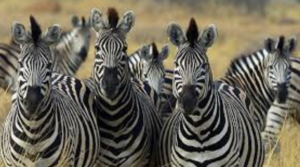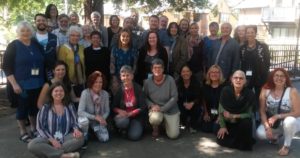 Watch any nature documentary about grazing animals. Zebras or Gazelles or Antelope. Or rodents that gather in groups, like Meerkats or Prairie Dogs. When one member of the herd raises the alarm – a chirp, a dive into their hole, a quick dash, a loud snort – everyone responds. They themselves haven’t seen the danger, but their neurology is tuned to “trust” the alarm of the herd, assume the danger, and take action. Run! In this way, fear is usefully viral.
Watch any nature documentary about grazing animals. Zebras or Gazelles or Antelope. Or rodents that gather in groups, like Meerkats or Prairie Dogs. When one member of the herd raises the alarm – a chirp, a dive into their hole, a quick dash, a loud snort – everyone responds. They themselves haven’t seen the danger, but their neurology is tuned to “trust” the alarm of the herd, assume the danger, and take action. Run! In this way, fear is usefully viral.
It works the other way, too. When the danger passes, and a few key members calm down, take big sighs, and return to eating, that spreads as well. The take cues from each other, and relax quite naturally, and get back to ordinary business. Safety is viral, too.
We humans aren’t so different from these animals. Our neurology mostly works the same way – when the “herd” feels fear or danger, we all do; when the group feels safe and well, we all do. It actually takes a lot of training to remain calm in an atmosphere of alarm (think of a fighter pilot or EMT professional). It’s hard to avoid “picking up” a sense of danger in a workplace, neighborhood, or crowd that is feeling under threat.
It is similarly hard to resist the sense of safety that comes through a group that feels good and well about itself. Maybe you had a magical workplace, or a church, or a volunteer organization that just felt, well, good to be part of. When that happens, we notice the virality of safety.
 This is a very important aspect of groups. When they feel chronically in danger, everyone feels stressed and they don’t function at their best. Whatever they are up to becomes hard and a daily burden. When they feel safe, is is a joy to show up, contribute, and share the sense that what we are doing has value.
This is a very important aspect of groups. When they feel chronically in danger, everyone feels stressed and they don’t function at their best. Whatever they are up to becomes hard and a daily burden. When they feel safe, is is a joy to show up, contribute, and share the sense that what we are doing has value.
Simon Sinek has talked about this at great length. Check out his short TED Talk, and his very valuable longer video (where he goes into the neurochemistry of these states in a really compelling way).
This is a topic of great importance to me. A large part of what I do is lead small groups, project teams, and large organizations. Setting a tone of group safety and respect is critical for good functioning and just overall fun. (Which is really what we all want, right? It’s so motivational!) I am heart-broken by the amount of effort that goes wasted in organizations where the leadership, the structure, and/or a history of trauma that has gone unaddressed makes safety so unavailable.
One of the most rewarding aspects of leadership is creating safe, yummy environments, and inviting others to join in. It is a high priority for the West Coast Constellations Intensive, particularly because we are doing tender, vulnerable work together, and without safety, the accumulated trauma of our pasts can completely swamp the experience. But with safety, we can feel courageous, adventurous and even a bit playful about diving into this kind of work together. (The West Coast Constellations Intensive meets March 8-12th in Santa Cruz, CA. Save $300 on registration through this Thursday, January 10th.)
When have you experienced group safety? When have you experience workplace or other group context that was seemed in permanent alarm? I invite you to share your stories on my blog, below.
Leave a Reply